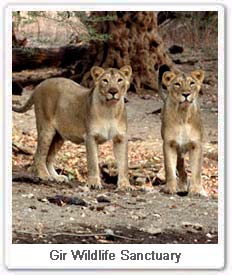Major Attractions : Asiatic Lions, Leopards, Chowsingha
Area Covered : 1412.13 sq-km.
Ideal Time to Visit the Park : Can visit Gir park throughout the year, but the best time to visit the Gir Sanctuary is between the months of November and June.
Nearest Attractions : Tracks to Deva Danga, Riley's, Bawal Chowk, Kankai, Chodardi, Tulsishyam and Kamleshwar dam/lake.
Some Major Accesses : Sasan (1 km), Junagadh (42 km), Ahmedabad (400 km), Veraval, Somnath.
Things to Know
Where is the Gir Wildlife Sanctaury?
The Gir National Park, the home of the Asiatic lion is located among the low, undulating and excellently irrigated hills in the Junagadh district of Gujarat in India.

Gir Wildlife Sanctuary in Gujarat was created to protect the last wild population of Lion outside the African regions. Since 1913 when the Lion population over here fell drastically to just 20 animals, the numbers have grown to around 300.
The Climate in Gir Wildlife Sanctaury
The park receives a good annual rainfall averaging 1000 mm. The temperatures at the park vary to extremes. In winters, the temperatures go down to as low as 6 degrees centigrade, while soaring up to a scorching 46 degrees in the summers.
The Ecological System in the Gir Wildlife Sanctaury
The Flora in Gir National Park
The Gir National Park is a mixed deciduous forest with well spread stock of teak, flame of the forest, some Acacia and Banyan trees. A unique belt of vegetation is found along the main rivers and streams. Species like the Jamun, Karanj, Ber, Tendu, Semul, Umro, Vad, Kalam, Charal, Sirus and Amli are found here. These trees are mostly broad leaved and evergreen, giving the area a cool shelter and the moisture content.
The Fauna in the Gir Wildlife Sanctuary
Gir is not just about Indians Lions, the second most commonly found predator in the Gir is Leopard. Infact, Gir national park also houses one of the largest Leopard populations in any park in India, and especially in the hotter season they can sometimes be seen at night close to the tourist lodges.
Other animal residents of the Gir national park are Sambar, Chital, Nilgai, Chowsingha, Chinkara Gazelle, Wild Boar, Langur, Jackal, Panthers, Wild Cats and Hares and Hyena.

The Avifauna in the Gir Wildlife Sanctuary
The presence of a large number of water bodies and suitable climatic conditions prevalent within the park has made it a haven for a large number of bird species. Numerous birds like Paradise Flycatchers, Black headed Cuckoo Shrike, Gray Drongo, Pied Woodpeckers, Coppersmiths, Indian Rollers, Crested Swifts, Fish Owls, Black Vultures, Shaheen Falcons, Bonelli's Eagles, Flamingo, Crested Serpent Eagles, Painted Sandgrouse, Rock Bush Quail, Gray Partridge, Painted Storks and White Necked Storks are found here.
The Reptiles in the Gir Wildlife Sanctuary
The reptile population of the park is mainly represented by Marsh Crocodiles, Monitor Lizards, Pythons and a large variety of snakes. There is an interesting breeding farm for crocodile at Sasan, which also provides the specimens that are relocated into the water reservoirs inside Gir.
Safaris in the Gir Wildlife Sanctuary
Jeep Safari
The best way to see the big cats is, of course, in their natural habitats, at dawn and dusk, when they are on the prowl. Wildlife viewing in the Gir's is best done, by driving a jeep around the forest.
Gir Wildlife Sanctuary Travel Circuit
Delhi - Rann of Kutch - - Gondal - Gir National Park - Dandeli Wildlife Sanctuary - Goa - Mumbai
How to Reach Gir Wildlife Sanctuary?
Air : The nearest airport from Gir is Keshod 90 km via Veraval. Visitors can easily catch daily flights from Mumbai to Keshod.
Rail : The nearest rail connection is the meter gauge rail line of 395 km from Ahemdabad.
Road : Gir is situated at a distance of 400 km from Ahmedabad via Rajkot, Junagadh and Mendarda. State Transport buses are easily available from Junagadh and Veraval to Gir, between November and June.






